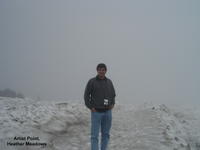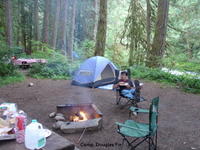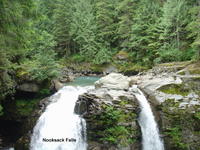What a day for Mumbai......it rained 37 inches in 21 hours.....that is the highest recorded rainfall in day for over a century in
One of my friends coming to US had to turn back (as did thousands of other traveller's) as all flights were cancelled. So were the trains and the roads were blocked too...the city was completely cut-off from the rest of the country....
well that's monsoon back home.....I am just hoping that life returns to normalcy as soon as possible.
Wednesday, July 27, 2005
37 inches of rain in a day...that's crazy !!!!
Tuesday, July 26, 2005
How i yearn for the rains...
The last ten days have been an extremely dry and hot (for seattle) with temperatures in mid 80's. No rains and no clouds in sight...it is just burning down here....
Saturday, July 23, 2005
Mount St. Helens
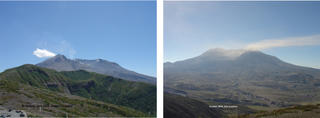
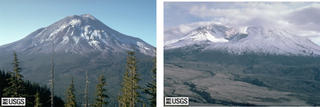
Today was my 5th visit Mount St. Helens. It is perhaps the most active volcano in continental North America.
The last major eruption occurred during May 1980. This eruption completely changed the landscape, converting the once richly forested region into a lunar like dead surface. Life has since begun to return to the mountain. But the mountain is very much active even today. St Helens remained pretty much dormant from 1980 until about 2004 when once again it shook to life, this time with steam and ash eruptions. Today the mountain is highly active with sporadic ash eruptions and almost continuous steam eruptions.I had visited the mountain last year during the eruptions, in fact I was at the Johnston observatory when it was evacuated and closed. It has recently been reopened again. I visited St. Helens again this January and it was still steaming. In fact today morning there was a small ash eruption and steam eruptions continued throughout the day. We went to the windy ridge viewpoint today. You can also see the live Mount St. Helens web-cam here.
The photographs showing the comparison before and after the 1980 eruption have been taken from USGS/CVO archives.
Friday, July 22, 2005
Gene Transfer from Bacteria to Plants : Genetic Engineering in Nature

Agrobacterium tumefaciens, a common soil bacterium causes the destructive plant disease, crown gall, characterized by the formation of tumorus overgrowths at the site of infection. These overgrowths result from the transfer of DNA and proteins from Agrobacterium into plant cells where the DNA is integrated into the plant genome, and expressed, leading to the synthesis of plant growth regulators and food for the bacteria. This transfer of DNA from a prokaryote to a eukaryote is the only recognized natural example of trans-kingdom gene transfer. Indeed, most tobacco plants contain Agrobacterium genes that resulted from an infection in the distant past. Interestingly, the transfer mechanism used by Agrobacterium is common to the mechanism used by many human pathogens to transfer proteins into human cells, thereby causing disease. This natural genetic engineer has been exploited to genetically transform agriculturally important plants to confer resistance to a wide range of harmful pests, such as insects and viruses, as well as to herbicides. Agrobacterium can transfer DNA into many other eukaryotes including algae, fungi and human cells in the laboratory. Other bacteria, besides Agrobacterium are now being developed to genetically engineer plants and other organisms. What many biologists once thought could never happen in Nature is, in fact, a rather common occurrence and its mechanism is far more interesting than was ever envisioned.
Summary of talk by Dr.Eugene Nester at the University of Washington science colloquium.
Saturday, July 16, 2005
Harry Potter
Atlast ...the sixth book in the series Harry Potter and the half blood prince is out. I finished reading it (yes...i am harry potter fan). I guess the story gets more exciting , but I liked the first three books more.
Monday, July 11, 2005
Lazy weekend
Monday...and back to work...this weekend was really slow...overcast and dull weather... atleast i got some work done...watched "Batman Begins" on saturday...found it ok...i liked the joker one better.
Wednesday, July 06, 2005
Freedom :- By Vinit Ogale
A look at Freedom :- Vinit Ogale
What is freedom ? The right to be free, the state of being free ? Which of course forces us to ask free from what ? As we think about it, it suddenly dawns upon us that freedom is not really easy to understand, much less define. On looking up its definition we see that freedom is "liberation from slavery or restraint or from the power of another". So is that really freedom? Who then truly is free? Is freedom then just another yard spun old wives tale. No, it is not so. Is your freedom so fragile that it can be shattered into a million pieces by simple act of restraint. Do you rob you child of its freedom when you force him to eat spinach at dinner.
The true meaning of freedom, I believe is simply the power to think. No man, beast or machine can ever strip you of your freedom. Each and every person has within him the power to free himself. Placing someone in a cell can never imprison his mind. Covering his eyes can not curtail his sight. But convince him to stop thinking and you have imprisoned him for eternity.
This leads us to religion and religious instruction. So often, we see around us, someone saying that earth is flat, pigs can fly and not going to church is heretic. Do they stop and think "Why?". Of course, they say,because the orange catholic vedas or the Dela Lama says so. Please understand here that I am not attacking what the orange vedas or Dela Lama says. In fact I hold both in high regard because they like all free people represent and embody independent thought. But the written word no matter how ancient or widely accepted can never replace what you think. If you read something and agree with it then you still remain free. But once you start justifying your actions by resting on the orange catholic vedas and not the pillars of independent thought, you throw away your priceless freedom just so that you no longer need to take the effort to think.
What is freedom ? The right to be free, the state of being free ? Which of course forces us to ask free from what ? As we think about it, it suddenly dawns upon us that freedom is not really easy to understand, much less define. On looking up its definition we see that freedom is "liberation from slavery or restraint or from the power of another". So is that really freedom? Who then truly is free? Is freedom then just another yard spun old wives tale. No, it is not so. Is your freedom so fragile that it can be shattered into a million pieces by simple act of restraint. Do you rob you child of its freedom when you force him to eat spinach at dinner.
The true meaning of freedom, I believe is simply the power to think. No man, beast or machine can ever strip you of your freedom. Each and every person has within him the power to free himself. Placing someone in a cell can never imprison his mind. Covering his eyes can not curtail his sight. But convince him to stop thinking and you have imprisoned him for eternity.
This leads us to religion and religious instruction. So often, we see around us, someone saying that earth is flat, pigs can fly and not going to church is heretic. Do they stop and think "Why?". Of course, they say,because the orange catholic vedas or the Dela Lama says so. Please understand here that I am not attacking what the orange vedas or Dela Lama says. In fact I hold both in high regard because they like all free people represent and embody independent thought. But the written word no matter how ancient or widely accepted can never replace what you think. If you read something and agree with it then you still remain free. But once you start justifying your actions by resting on the orange catholic vedas and not the pillars of independent thought, you throw away your priceless freedom just so that you no longer need to take the effort to think.
Monday, July 04, 2005
Mt.Baker (Day 2)
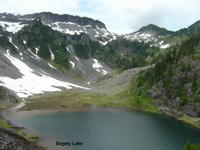
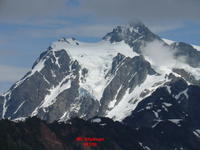
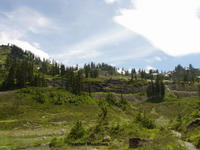
Sunday was a perfect day for hiking. We went hiking along the trails starting from the Heather Meadows area. Located along the upper reaches of the Mt.Baker byway this spectaular subalpine setting offers summer day use recreation along a network of scenic trails. We took the Bagely lakes trail and continued on to the Chain lakes trail. The Bagely lakes trail is a short 1.5 mile loop around the Heather Meadows, while the Chain lakes trail is about a 6 mile loop. It has an elevation gain of about +1700 ft /-1700 ft. We then went up to Artist Point, which offers stunning views of Mt.Baker and Mt.Shuksan
Sunday, July 03, 2005
Mt.Baker (Day 1)
This weekend we (me and my brother) went camping to Mt.Baker national forest. The Mt. Baker-Snoqualmie National Forest in Washington State extends more than 140 miles along the western slopes of the Cascade Mountains from the Canadian border to the northern boundary of Mt. Rainier National Park. We camped at Douglas Fir campgrounds. Our campground was on banks of North Fork Nooksack river.....It was simply awesome. We left on Friday night reaching Baker early Saturday morning. After setting up our camp we drove up to Austin pass..The highest point accessible by vehicle. On the way we took a short detour to Nooksack falls. This falls plumments more than 100 feet over rocky outcrops. At Austin pass we ran into some bad weather and it was cold and covered in clouds....So all we could see was clouds and clouds....But that too was superb. So we returned back to camp...and chilled out.
Unfortunately we did not get a chance to see the Tempe comet as I had hoped too.
Unfortunately we did not get a chance to see the Tempe comet as I had hoped too.
Friday, July 01, 2005
Deep Impact
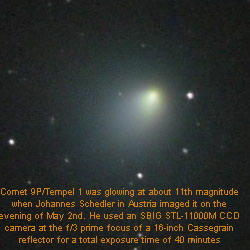
NASA's Deep Impact spacecraft is set to intercept the comet Tempe1. Impact with the comet is scheduled for 1:52 a.m. EDT, July 4 (10:52 p.m. PDT, July 3). Deep Impact consists of a subcompact-car-sized flyby spacecraft and an impactor, about the size of a washing machine. The dual spacecraft carry three imaging instruments, two on the flyby and one on the impactor. The impactor has an auto-navigation system that will make final corrections to its flight path just minutes before the scheduled collision. Scientists hope the resulting crater will expose fresh material from below the comet's surface and subsurface. Comets are time capsules that hold clues about the formation and evolution of the solar system. They are composed of ice, gas and dust, primitive debris from the solar system's distant and coldest regions that formed 4.5 billion years ago. Deep Impact will be the first space mission to probe beneath the surface of a comet and reveal the secrets of its interior.
Altough the chances are low I am hoping to catch a glimpse of the comet with my telescope (ORION StarMax™ 102mm EQ Compact "Mak"). I am going to Coho campgrounds in the Olympic National Park which should be a good site if the sky is clear. The comet will be located in our southwestern skies, just a bit above the star Spica, in the constellation of Virgo. You can find Spica by first finding Jupiter -- extremely bright in the west -- and then looking "left" towards the south. More information can be found here.
Altough the chances are low I am hoping to catch a glimpse of the comet with my telescope (ORION StarMax™ 102mm EQ Compact "Mak"). I am going to Coho campgrounds in the Olympic National Park which should be a good site if the sky is clear. The comet will be located in our southwestern skies, just a bit above the star Spica, in the constellation of Virgo. You can find Spica by first finding Jupiter -- extremely bright in the west -- and then looking "left" towards the south. More information can be found here.
Subscribe to:
Posts (Atom)
